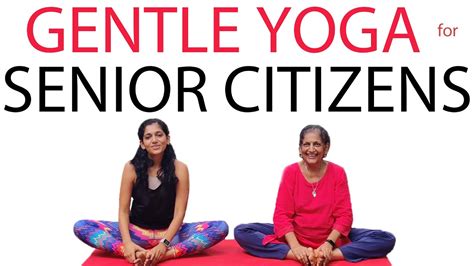Gentle Yoga for Seniors: Top Poses to Boost Flexibility and Wellness Today
As we age, maintaining flexibility, balance, and strength becomes increasingly important for both physical and mental well-being. One of the most effective and low-impact ways for seniors to achieve these benefits is through gentle yoga. Whether you’re a complete beginner or have some experience, gentle yoga is accessible and can easily be adapted to meet your needs. In this article, we will explore key poses, provide practical tips, and address common misconceptions about practicing yoga as a senior. Additionally, we will delve into the historical roots of yoga, its modern applications, and how seniors can implement it into their daily routines safely and effectively.
Key Concepts in Gentle Yoga for Seniors
Understanding the fundamentals of gentle yoga is critical for a successful practice. Let’s define the key elements:
- Adaptability: Yoga poses can be modified to suit varying mobility levels, making it accessible for everyone.
- Low-impact: Gentle yoga focuses on movements that do not place undue stress on joints or muscles.
- Breathwork: Breathing exercises are a central aspect, promoting relaxation and mindfulness.
- Balance & Stability: Many poses emphasize improving balance, which is crucial for seniors to prevent falls.
Common Poses for Seniors
| Pose Name | Benefits | How to Modify |
|---|---|---|
| Mountain Pose (Tadasana) | Improves posture, balance, and alignment. | Hold onto a chair for support if necessary. |
| Chair Pose (Utkatasana) | Strengthens legs and improves balance. | Sit on a chair and slowly rise halfway up to ease strain on the knees. |
| Tree Pose (Vrksasana) | Boosts balance and coordination. | Hold onto a wall or sturdy surface if needed. |
| Seated Forward Bend (Paschimottanasana) | Stretches the back and hamstrings. | Perform while sitting on a chair for better ease of movement. |
| Cat-Cow Stretch (Marjaryasana-Bitilasana) | Promotes spine flexibility and core strength. | Can be done standing, using a chair for support if kneeling is uncomfortable. |
Historical Context of Yoga
The origins of yoga date back over 5,000 years to ancient India, where it was practiced as a spiritual and philosophical discipline. While initially focused on meditation and breath control, modern yoga has evolved to emphasize physical postures, or “asanas,” which help improve flexibility, strength, and balance. Despite its long history, the adaptation of yoga for seniors is a relatively recent phenomenon, coinciding with the broader shift towards mind-body wellness in modern medicine.
Current State Analysis: Why Yoga is Ideal for Seniors
Many seniors face challenges such as joint pain, reduced mobility, and a higher risk of falls. Regular yoga practice has been shown to address these issues by improving joint flexibility, enhancing balance, and strengthening muscles. Additionally, yoga encourages mindfulness, reducing stress and improving overall mental well-being. Research has shown that gentle yoga can lead to improvements in sleep quality, reduced anxiety, and better cognitive function among older adults.
Practical Applications: How Seniors Can Start Yoga
Beginning a yoga practice can feel overwhelming, but with the right approach, seniors can safely integrate yoga into their routine. Here are some practical tips for getting started:
- Consult Your Doctor: Before starting any new exercise, it’s important to consult a healthcare provider, especially if you have pre-existing conditions like osteoporosis or arthritis.
- Find a Qualified Instructor: Look for instructors experienced in teaching seniors and familiar with modifications for limited mobility.
- Use Props: Chairs, blocks, straps, and blankets can help make poses more accessible.
- Start Slow: Focus on gentle stretching and balance poses at the beginning. Gradually build strength and flexibility over time.
Case Studies: Seniors Transforming Their Health with Yoga
To illustrate the positive impact of yoga, consider the following examples:
- Mary, Age 67: After experiencing chronic back pain, Mary started practicing gentle yoga. Within six months, she reported reduced pain, improved mobility, and an overall boost in mood.
- John, Age 72: John had difficulty balancing and was at risk of falling. After incorporating balance poses like Tree Pose and Mountain Pose, his balance improved significantly, and he feels more confident walking unaided.
Stakeholder Analysis: Who Benefits from Senior Yoga?
The benefits of yoga for seniors extend beyond just individuals. The following groups also have a vested interest:
- Seniors and Caregivers: Yoga can enhance quality of life for seniors while reducing the physical strain on caregivers.
- Healthcare Providers: Incorporating yoga into treatment plans can lead to better patient outcomes and reduce the need for medications.
- Fitness Instructors: By catering to older clients, yoga instructors can diversify their services and reach a new demographic.
Implementation Guidelines: How to Safely Incorporate Yoga into Daily Life
To safely include yoga in a senior’s daily routine, follow these guidelines:
- Start with Warm-Up: Gentle warm-up exercises help prepare the body and prevent injury.
- Incorporate Balance Poses: Balance is critical for seniors to reduce fall risks. Focus on poses like Tree Pose and Warrior III.
- Stretch Mindfully: Avoid overstretching, especially in areas where joints are sensitive, such as the hips and knees.
- Use Modifications: Chairs, walls, and props can help reduce strain and make poses more accessible.
- End with Relaxation: Finish each session with deep breathing or meditation to promote relaxation.
Ethical Considerations: Inclusivity and Respect for Aging Bodies
While promoting yoga for seniors, it is essential to recognize the physical limitations that come with age. Yoga should never feel competitive or overwhelming. Respect for individual differences is critical. Ethical instructors will focus on creating a safe, inclusive space where every participant feels comfortable exploring their abilities without judgment.
Limitations and Future Research
Despite the many benefits, there are limitations to consider when encouraging seniors to practice yoga. For those with severe mobility issues, yoga may require significant modifications, or in some cases, may not be suitable at all. Future research should explore how to further adapt yoga for individuals with disabilities, as well as investigate the long-term cognitive benefits of yoga for seniors.
Expert Commentary
Experts in geriatrics and physical therapy increasingly recognize the value of yoga for older adults. Dr. Susan Levine, a geriatric physician, notes, “The gentle movements and focus on balance make yoga one of the best activities seniors can engage in. It’s not just about physical health—there’s a significant mental and emotional benefit too.” Meanwhile, yoga instructor Sarah Collins emphasizes the importance of adaptability, “Yoga can be tailored to meet each person where they are. You don’t have to be flexible to start. The flexibility comes with practice.”
With its broad range of physical and mental benefits, gentle yoga offers an accessible, effective way for seniors to stay active and maintain their well-being. By following the guidelines and modifications outlined in this article, seniors can safely enjoy the practice and experience the transformative effects of yoga in their daily lives.








